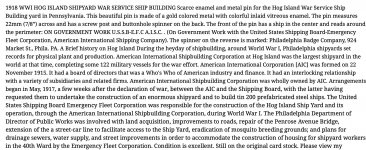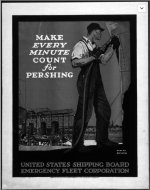Navigation
Install the app
How to install the app on iOS
Follow along with the video below to see how to install our site as a web app on your home screen.
Note: This feature may not be available in some browsers.
More options
You are using an out of date browser. It may not display this or other websites correctly.
You should upgrade or use an alternative browser.
You should upgrade or use an alternative browser.
✅ SOLVED Shipyard tag? Would love anyone with more info
- Thread starter JayGinSC
- Start date
WWI era
E.F.C. = Emergency Fleet Corporation,
A.I.S.C. = American International Shipping Company
Probably a tool check.
(Photo compliments of: https://www.worthpoint.com/worthopedia/1918-wwi-hog-island-shipyard-war-52060049)
E.F.C. = Emergency Fleet Corporation,
A.I.S.C. = American International Shipping Company
Probably a tool check.
(Photo compliments of: https://www.worthpoint.com/worthopedia/1918-wwi-hog-island-shipyard-war-52060049)
Attachments
Last edited:
Upvote
0
Red-Coat
Gold Member
Just to add to that history, the EFC (Emergency Fleet Corporation) was formed on 16th April 1917and continued under that name after the war, until it was renamed to the US Shipping Board Merchant Fleet Corporation on 11th February 1927.
Although the AISC Hog Island shipyard was the largest in the world at the time it was essentially an assembly facility, with up to 80% of each hull being prefabricated elsewhere. They built 122 ships under the EFC programme – mostly cargo vessels and a few troop transports. None of them were completed in time to serve in WWI, the first being christened on 5th August 1918 as SS Quistconck (the keel having been laid down as SS Red Jacket), but some of them saw service in WWII. Shipbuilding by AISC continued there until 1921 when the company was dissolved and the facility demolished. Philadelphia International Airport now sits on the site.
So, the tool check could be between May 1917 and January 1921 when AISC delivered the last of the ships it had been contracted for and the remaining orders were cancelled.
Although the AISC Hog Island shipyard was the largest in the world at the time it was essentially an assembly facility, with up to 80% of each hull being prefabricated elsewhere. They built 122 ships under the EFC programme – mostly cargo vessels and a few troop transports. None of them were completed in time to serve in WWI, the first being christened on 5th August 1918 as SS Quistconck (the keel having been laid down as SS Red Jacket), but some of them saw service in WWII. Shipbuilding by AISC continued there until 1921 when the company was dissolved and the facility demolished. Philadelphia International Airport now sits on the site.
So, the tool check could be between May 1917 and January 1921 when AISC delivered the last of the ships it had been contracted for and the remaining orders were cancelled.
Upvote
0
WWI era
E.F.C. = Emergency Fleet Corporation,
A.I.S.C. = American International Shipping Company
Probably a tool check.
(Photo compliments of: https://www.worthpoint.com/worthopedia/1918-wwi-hog-island-shipyard-war-52060049)
You're the man my friend!

Great I.D.
Dave
Upvote
0
Just to add to that history, the EFC (Emergency Fleet Corporation) was formed on 16th April 1917and continued under that name after the war, until it was renamed to the US Shipping Board Merchant Fleet Corporation on 11th February 1927.
Although the AISC Hog Island shipyard was the largest in the world at the time it was essentially an assembly facility, with up to 80% of each hull being prefabricated elsewhere. They built 122 ships under the EFC programme — mostly cargo vessels and a few troop transports. None of them were completed in time to serve in WWI, the first being christened on 5th August 1918 as SS Quistconck (the keel having been laid down as SS Red Jacket), but some of them saw service in WWII. Shipbuilding by AISC continued there until 1921 when the company was dissolved and the facility demolished. Philadelphia International Airport now sits on the site.
So, the tool check could be between May 1917 and January 1921 when AISC delivered the last of the ships it had been contracted for and the remaining orders were cancelled.
Good history Red-Coat!
Attachments
Upvote
0
- Thread starter
- #8
After doing some additional research based on the tool check ID by creskol (fantastic ID btw), I found this article in the Pacific Marine Review Volume 17 page 85 from September 1920 called "Tool Methods At Hog Island". In there, I found the information below.
"PROTECTION TO EMPLOYES
The brass checks are kept upon a nail against the rack space provided for each machine, together with a metal disc bearing the serial number and shop number of the machine, and are turned face back to protect the employe from having his check called for by another employe who might attempt to obtain false credit at the tool room by lifting his fellow employe's check and placing same on some other tool.
The checks of the respective tool stations are also numbered on the reverse side with their particular yard numbers to guard against the issuance of tools or machines to employes from other yards. The reason for forcing an employe to withdraw equipment only from the station in his division will be readily grasped when it comes to clearance upon termination.
Furthermore, the checks are assigned by the service station to the various crafts in blocks. That is, 100 to 499 might be issued only to riveters, 600 to 9919 only to drillers and reamers, and so on. This facilitates rapid service during the peak hours-namely, at starting time in the forenoon and closing time in the afternoon-and makes for efficiency on the part of the tool room employe, as he can easily spot the checks in the craft which he serves. It might be of interest to say at this point that the service force is approximately one to every seventy-five employes in the tool using crafts."
https://books.google.com/books?id=oq0-AQAAIAAJ&pg=RA2-PA85&lpg=RA2-PA85&dq=hog+island+tool+check+brass&source=bl&ots=bwSOFuXsv0&sig=ACfU3U1eTWVoiqrC0O1c5w2uQsHDhUEJUg&hl=en&sa=X&ved=2ahUKEwijmabCodrpAhXzlHIEHdtEDGQQ6AEwAHoECAsQAQ
I wish I knew what tool this was assigned to but I am very happy to find a piece of history in my backyard. Thanks again to creskol and all of you for the information provided.
"PROTECTION TO EMPLOYES
The brass checks are kept upon a nail against the rack space provided for each machine, together with a metal disc bearing the serial number and shop number of the machine, and are turned face back to protect the employe from having his check called for by another employe who might attempt to obtain false credit at the tool room by lifting his fellow employe's check and placing same on some other tool.
The checks of the respective tool stations are also numbered on the reverse side with their particular yard numbers to guard against the issuance of tools or machines to employes from other yards. The reason for forcing an employe to withdraw equipment only from the station in his division will be readily grasped when it comes to clearance upon termination.
Furthermore, the checks are assigned by the service station to the various crafts in blocks. That is, 100 to 499 might be issued only to riveters, 600 to 9919 only to drillers and reamers, and so on. This facilitates rapid service during the peak hours-namely, at starting time in the forenoon and closing time in the afternoon-and makes for efficiency on the part of the tool room employe, as he can easily spot the checks in the craft which he serves. It might be of interest to say at this point that the service force is approximately one to every seventy-five employes in the tool using crafts."
https://books.google.com/books?id=oq0-AQAAIAAJ&pg=RA2-PA85&lpg=RA2-PA85&dq=hog+island+tool+check+brass&source=bl&ots=bwSOFuXsv0&sig=ACfU3U1eTWVoiqrC0O1c5w2uQsHDhUEJUg&hl=en&sa=X&ved=2ahUKEwijmabCodrpAhXzlHIEHdtEDGQQ6AEwAHoECAsQAQ
I wish I knew what tool this was assigned to but I am very happy to find a piece of history in my backyard. Thanks again to creskol and all of you for the information provided.
Upvote
0
Users who are viewing this thread
Total: 2 (members: 0, guests: 2)








